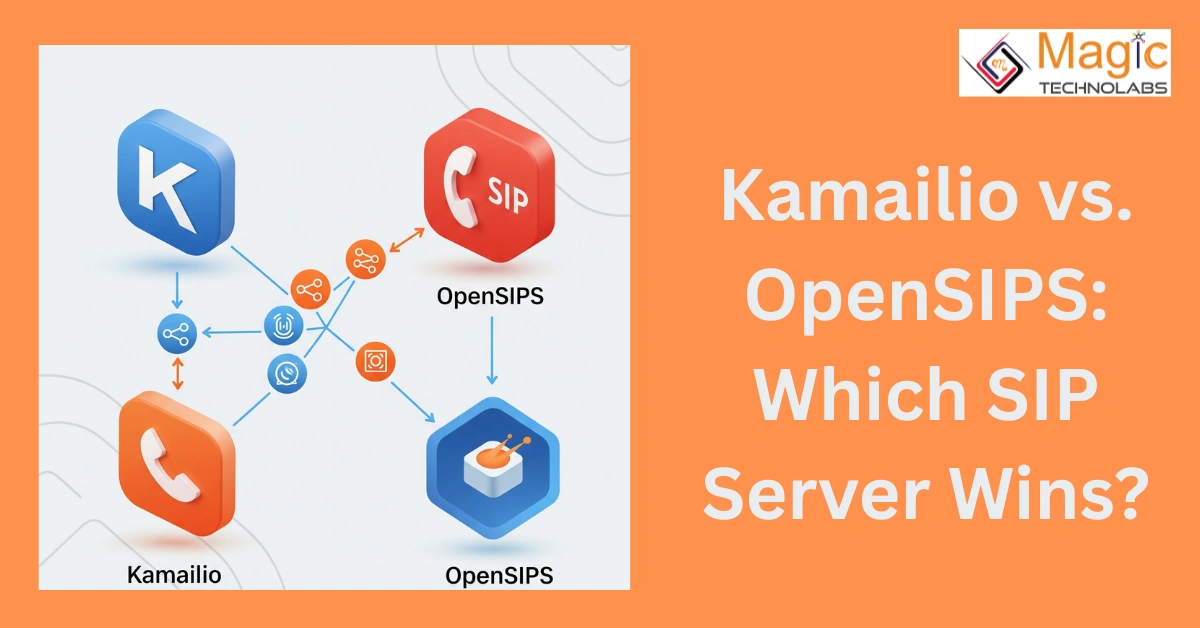Ever wonder what makes those crystal-clear Voizcall conversations and smooth video conferences happen? Behind the scenes, for many modern communication systems, there are powerful "SIP servers" acting like traffic cops for your calls. Today, we're diving into the exciting world of two giants in this space: Kamailio and OpenSIPS.
When you are developing a communication system, or perhaps you were just idle and wondering how your phone calls come about, you have probably heard the names. They both are hugely capable of making and receiving huge volumes of calls, highly efficient programs, and open-source workhorses. However, which is the appropriate champion that may suit your needs? Breaking it down to simple terms!
The Heavyweights: Kamailio & OpenSIPS Introduced
Consider you have a large phone business (hell, makeshift your business, hundreds of teleworkers). Each of such calls, each message, each video stream should reach the right ear. That is where SIP servers fall in. They are the brains of the system redirecting flows and ensuring perfection.They're like the central brains, routing connections and making sure everything flows perfectly.
Kamailio and OpenSIPS are simply fabulous at it. The two began with equal origin, yet after years, each has achieved its individual strengths and societies. You can imagine them as two very well trained brothers who have become specialists in neighbouring disciplines.
Head-to-Head:What Counts the Most?
In selecting among the two, there are some areas that are necessarily brought up. Now, let us compare how they rank.
1. Performance: The Speed Demons
Both Kamailio and OpenSIPS are known for being incredibly fast – we're talking about handling thousands of calls per second! This is where the term Kamailio high-performance SIP server truly shines. Both are built for speed and efficiency, making them ideal for large-scale deployments like a bustling contact center or a national telecom provider. You won't typically find one significantly "faster" than the other; rather, their performance depends more on how cleverly you set them up.
2. Features: What Can They Do For You?
This is where the nuances start to appear. Both offer a vast array of features crucial for modern communication:
Routing: Smartly directing calls based on rules.
Load Balancing: Spreading calls evenly to prevent overload.
Authentication: Making sure only authorized users connect.
Presence: Showing who's available or busy.
As with Kamailio Vs. OpenSIPS features, there is a great deal of similarity. But there are cases where you may get a module or a particular approach to dealing with a feature that fits better to your specific project. As an example, OpenSIPS has long had a bit higher focus on out-of-the-box billing functionalities, whereas Kamailio has tended to boast about ridiculous flexibility and writing custom scripts.
3. WebRTC Support: Connecting the Browser World
WebRTC (Web Real-Time Communication) is the magic behind making calls directly from your web browser, no special software needed. It's super important for modern tools like our own Voizcall web app. For Kamailio vs. OpenSIPS WebRTC support, both have robust capabilities. They act as "gateways," helping your browser communicate with traditional phone systems. You'll find excellent documentation and community support for implementing WebRTC with either of them.
4. Security: Keeping Your Calls Safe
Security in modern times is a must and not optional. In regard to security of Kamailio and OpenSIPS, the two projects are very serious. They provide such features as TLS/SSL encryption (scrambling your call data so that no one could spy on you), powerful authentication methods and security malpractice or attack prevention tools. Regularly updating your server and following best practices for configuration is key, no matter which one you choose. They both provide the foundational security features you need.
5. Scalability: Growing with Your Business
This is a huge pain point for many businesses. You start small, but then boom – your team grows, or your customer calls skyrocket! Can your communication system keep up? For Kamailio vs. OpenSIPS scalability, the answer is a resounding YES for both. They are designed from the ground up to handle massive loads and grow with your needs. You can add more servers, spread the load, and handle millions of users if needed. This is a core strength they share.
So, Who Wins? The Human Touch
The truth is, there's no single "winner" in the Kamailio vs. OpenSIPS debate. Both are incredibly powerful, flexible, and high-performance SIP servers that can handle almost anything you throw at them.
Here’s the simple human answer:
It often comes down to personal preference or existing team expertise. If your team is more familiar with one's scripting language or community, that might be your winner.
Your specific project needs. While features overlap, sometimes a tiny difference in how a specific module works or how a certain problem is solved might tip the scale.
Community and Documentation: Both have strong, helpful communities. A quick search for specific problems often reveals solutions from either side.
At Voizcall, we leverage robust, secure, and scalable technology to ensure your calls are always crystal clear and your team stays connected. Understanding the backbone of such systems helps us appreciate the engineering that powers modern communication.
Want to learn more about how powerful communication systems can solve your business's headaches? Stay tuned for more insights from Voizcall!
















